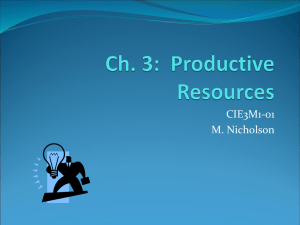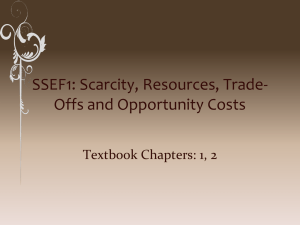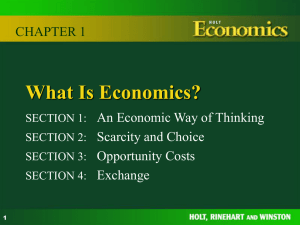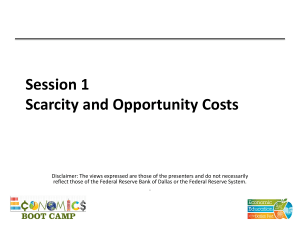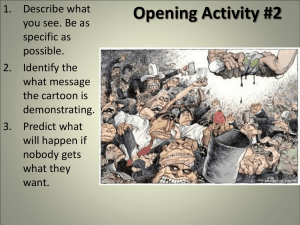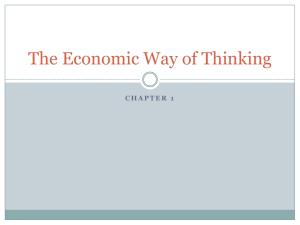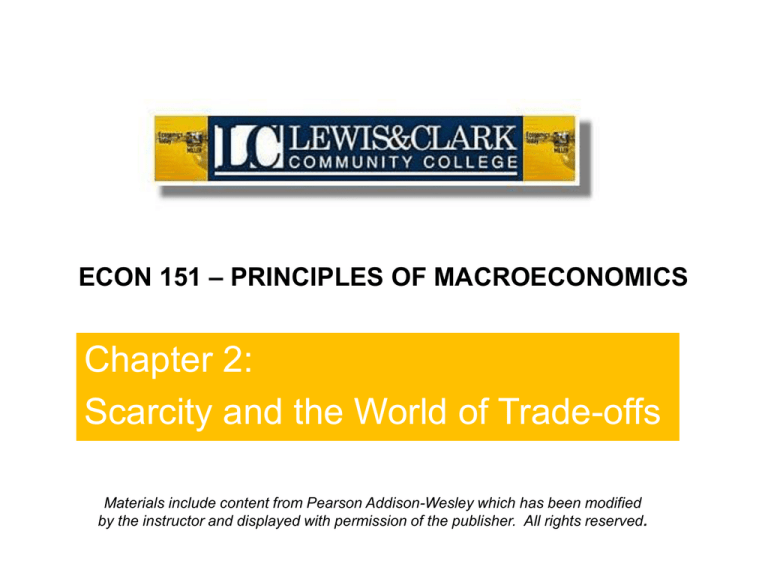
ECON 151 – PRINCIPLES OF MACROECONOMICS
Chapter 2:
Scarcity and the World of Trade-offs
Materials include content from Pearson Addison-Wesley which has been modified
by the instructor and displayed with permission of the publisher. All rights reserved.
Introduction
Society always faces choices regarding
use of its scarce resources. The need to
devote more law enforcement resources
to antiterrorism efforts means that
crimes considered less threatening,
such as bank robberies, are on the rise.
2
Scarcity
Scarcity
Occurs
when the ingredients (resources) for
producing things that people desire
are insufficient to satisfy all wants
3
Scarcity
What scarcity is NOT:
It
is not a shortage.
It is not the same thing as poverty.
4
Scarcity
Production
Any
activity that results in the conversion of
resources into products that can be used in
consumption
Resources or Factors of Production
Inputs
that are used to produce things
that people want
5
Scarcity
Resources or Factors of Production
Land
Natural resources or the gifts of nature
Labor
The human resource
6
Scarcity
Resources or Factors of Production
Physical
All manufactured resources
Human
Capital
Capital
Accumulated training and education
of workers
7
Scarcity
Resources or Factors of Production
Entrepreneurship
Person who organizes, manages,
and assembles the other resources
Risk taker
Maker of basic business policy decisions
8
Scarcity
Goods versus Economic Goods
Goods
are all things from which individuals
derive satisfaction and are, thus, valued.
Economic goods are goods and services
produced from scarce resources.
9
Scarcity
Services
Tasks
that are performed for someone else
Sometimes referred to as “intangible goods”
10
Wants and Needs
Needs (from the economic perspective)
Are
objectively undefinable
Could
be a wish, want, or a life-saving
necessity
Wants
Desirable
People
things that people wish to have
have unlimited wants
11
Scarcity, Choice,
and Opportunity Cost
Opportunity Cost
The
highest-valued, next-best alternative that
must be sacrificed to attain something or
satisfy a want
12
Scarcity, Choice,
and Opportunity Cost
In economics, cost is always
a forgone opportunity.
13
Scarcity, Choice,
and Opportunity Cost
Limited Resources & Unlimited Wants
Scarcity
Choices
Opportunity Cost
14
The World of Trade-Offs
Whenever resources are used
for any activity, the user is sacrificing the
opportunity to use those resources for
other things.
15
The World of Trade-Offs
Opportunity cost graphically:
The
production possibilities curve (PPC)
represents all possible maximum
combinations of total output that could be
produced.
Along the production possibilities curve, there
is a fixed quantity of productive resources of a
given quality being used efficiently.
16
Production
Possibilities Curve (PPC)
Figure 2-1
17
Production
Possibilities Curve (PPC)
Questions
What
would happen to the production
possibilities curve if you spent more
time studying?
What would happen to the potential grades?
Is it possible that terms of the trade-off might
not be constant?
18
The Choices Society Faces
Production possibilities assumptions
Resources
are fully employed
Production is for a specific time period
Resources are fixed for the time period
Technology does not change over the
time period
19
The Choices Society Faces
Technology
Society’s
pool of applied knowledge
concerning how goods and services
can be produced
20
Society’s Trade-Off Between Digital
Cameras and Pocket PCs
Figure 2-2, Panel (a)
21
Society’s Trade-Off Between Digital
Cameras and Pocket PCs
Figure 2-2, Panel (b)
22
The Law of Increasing
Relative Costs
Figure 2-3
23
The Choices Society Faces
Law of Increasing Relative Costs
As
society attempts to produce more of a
good, the opportunity cost of additional units
of that good generally increases.
24
Economic Growth
and the Production Possibilities Curve
Economic growth
Increases
the production possibilities
of digital cameras and pocket PCs
Occurs over a period of time
Is illustrated by an outward shift
of the production possibilities curve
25
Economic Growth
Allows for More of Everything
Figure 2-4
26
The Trade-Off Between
the Present and the Future
The PPC can be used to illustrate
the trade-off between present and future
consumption.
Consumption
The
use of goods and services
for personal satisfaction
27
Capital Goods and Growth
Capital Goods per Year
Consumer goods
Goods
produced for
personal satisfaction
A
Capital goods
Goods
used to produce
other goods
B
7
8
Consumption Goods per Year
($ trillions)
28
Capital Goods and Growth
Recreation per Year
Capital Goods per Year
Future growth as a result
of A on the left-hand diagram
A
Today
B
7
8
Consumption Goods per Year
($ trillions)
Figure 2-5, Panel (a)
Food per Year
29
Capital Goods and Growth
Recreation per Year
Capital Goods per Year
Future growth as a result
of C on the left-hand diagram
C
A
Today
B
Consumption Goods per Year
($ trillions)
Figure 2-5, Panel (b)
Food per Year
30
Capital Goods and Growth
Observations
Forgo
consumption goods to produce capital
goods
Increase in capital goods stimulates economic
growth
31
Specialization
and Greater Productivity
Specialization
Division
of productive activities
Leads to greater productivity
32
The Choices Society Faces
Question
How
does the specialization of resources
influence the shape of the production
possibilities curve?
33
Specialization
and Greater Productivity
Absolute Advantage
The
ability to produce more units
of a good or using a given quantity
of labor or service resource inputs
34
Specialization
and Greater Productivity
Comparative Advantage
The
ability to produce a good
or service at a lower opportunity cost
A relative concept
Specialize in the production
for which we have a comparative advantage
35
Division of Labor
Division of Labor
Assigning
different workers different tasks to produce
a good or service
Organizing a division of labor within a firm to increase
output
Examples
Automobile
production
Hospital operating room
36
Comparative Advantage
and Trade Among Nations
Question
Why
trade?
Answer
Both
participating countries benefit
Comparative advantage and specialization
increases output and income of both
37
ECON 151 – PRINCIPLES OF MACROECONOMICS
Chapter 2:
Scarcity and the World of Trade-offs
Materials include content from Pearson Addison-Wesley which has been modified
by the instructor and displayed with permission of the publisher. All rights reserved.




